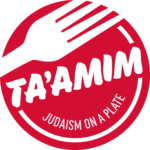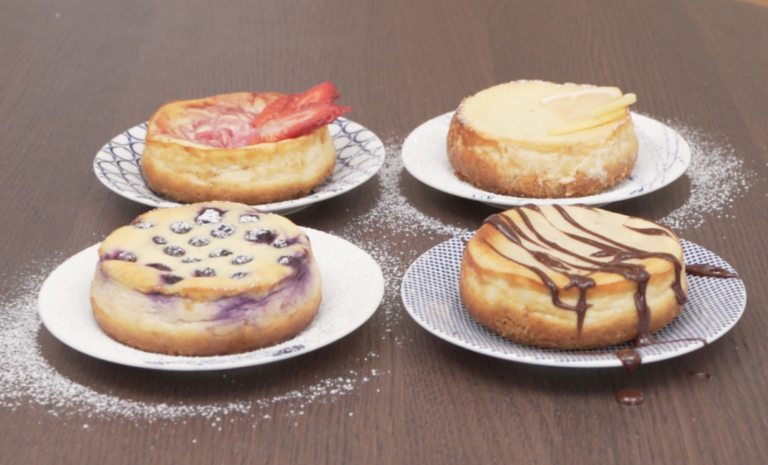Makes 8 mini (10cm / 4″) Cheesecakes or 1 large (23cm / 9”) ‘New York Style’ Baked Cheesecake
Prep time: 30 mins | Cooking time: approx 30 mins
Let’s talk about “The Cheesecake Festival”
Shavuot, widely known as “the cheesecake festival” actually plays a pivotal role in the story of the Jewish people.
More than the baked goods and dairy products that fill the bakery shelves at this time of year, Shavuot commemorates the Children of Israel receiving the Torah at the base of Mount Sinai, making this festival a central part of Jewish life to this very day.
Receiving the Torah caused the Children of Israel a mixture of euphoria and confusion. Though there were many new rules and regulations to adhere to, ultimately there was great joy and celebration as they now had the blueprint for how best to serve God, who brought us out of Egypt and freed us from servitude. Despite all the new rules, from that very first moment, the Children of Israel embraced the Torah.
So Why Dairy?
Receiving the Torah on Shavuot directly correlates with gaining the laws of Kashrut, and of separating meat and milk. Tradition tells us that the Torah was received on Shabbat. Faced with restrictions on how to butcher in a kosher fashion and the many rules of not transgressing Shabbat at the same time, the Children of Israel understood that they would have to wait until the end of Shabbat before taking an animal for their festive meal. This is one of the myriad reasons that many have the tradition of eating dairy on Shavuot.
But the Jewish connection to dairy goes on longer than Mount Sinai. While in modern times a festive meal might involve chicken soup and brisket, historically Jews were poor and rarely (if ever) part of the gentry or nobility. This meant that Jewish foods were not ones of wealth, with large cuts of meat certainly not on the menu. However, most families Ashkenazi, Sephardi and Mizrachi alike, did have a milking animal, the primary source of protein for the family. Subsequently, they would make soft or curd cheeses weekly and would get creative, serving cheese in a variety of ways—as a filling for pasta and pastry, on top of a slice of black bread or combined with stewed fruit or fresh vegetables.
So where did cheesecake come from?
Shavuot is both a historical holiday and an agricultural one. Always falling in spring when animals birthed and milk yield was high, the dairy production would go into overdrive, producing plenty of cheese, butter, sour milk and cream. To use up the excess cheese, ingenious cooks started using cheese in cakes, adding a touch of flour for stability, eggs as a setting agent, honey for sweetness and a pastry case as a base to hold the mixture together. In fact, the first time we hear of cheesecakes was in Ancient Greece. Still just as delicious, the basic cheesecake recipe has not changed much over millennia. To add some flare to your cheesecakes this Shavuot, why not try adding your own twist to your cheesecake. We’ve taken a traditional ’NY style’ baked cheesecake recipe and added some fruity additions to give a nod to the harvest festival, as well as a tasty chocolate cheesecake (because all cakes are better with chocolate). The mixture fills a single 23cm (9”) springform tin as one whole cake or fills eight mini 10cm (4”), round spring forms, to produce a series of smaller cakes—a fun way to try several different fillings.
Ingredients
For the base
- 170g (6oz / ¾ cup) butter, plus extra for greasing tin(s)
- 280g (10oz / 3 cups) digestive biscuits, made into fine crumbs
- 1½ tbsp sugar golden caster
For the cheesecake filling
- 1kg (2.2lb / 4 cups) full-fat soft cheese (can use cream cheese)
- 250g (9oz / 1 cup) golden caster sugar
- 3 tbsp plain flour
- 1½ tsp vanilla extract
- Finely grated zest of 1 lemon (about 2 tsp)
- 1½ tsp lemon juice
- 3 large eggs, plus 1 yolk
- 200ml (0.85 cups) carton soured cream
Optional Additions
- Small pack of blueberries
- 15 strawberries
- 125ml (½ cup) double cream
- 100g (3½ oz) cooking chocolate
Method
- Preheat your oven to 180°C (160°C Fan / 350°F / Gas Mark 4)
- Line the base of a springform tin: Either one 23cm or eight x 10cm spring form tins (available in packs of four – you can bake four at a time).
For the base:
- Crush 280g (10oz / 3 cups) biscuits
- Melt 170g (6oz / ¾ cup) of butter in a medium-sized pan and stir in the biscuits. Stir in 1tbsp of golden caster sugar until it is combined and well coated.
- Carefully press the mixture into the bottom of your cake tin(s). And bake in the oven for 10 minutes. Remove and leave to cool (inside the tins) on a wire rack.
- Up the temperature of the oven to 200°C (180°C Fan / 390°F / Gas Mark 6).
- In a mixer (you can use a large bowl with an electric whisk) beat 1kg (2.2lb / 4 cups) of full fat, soft cheese on a low speed until creamy. This should only take a couple of minutes.
- Slowly beat in 250g (9oz / 1 cup) of caster sugar (keeping the mixer on low). Then add in 3 tbsp of plain flour, and a pinch of salt. Scrape the sides of to combine the mixture and whisk until fully combined.
- Add in 1.5tsp vanilla extract, zest of a small lemon and 1.5tsp lemon juice
- Whisk in, one at a time, 3 large eggs and 1 egg yolk. Scrape the sides of the bowl intermittently. Whisk until well combined.
- Stir in 200ml of sour cream. Whisk to blend, but don’t overdo it. It should be light and fluffy at the end. Grease the sides of the springform. Pour the batter into your tin(s). Add your toppings according to the next step, or bake without additions for a plain baked cheesecake (skip to step 11).
- For the additions:
Blueberries (depending on cake tin size)
- Pour the cake mixture into the tin and then decorate the top with blueberries, you can be relatively generous, but don’t overfill. They will naturally sit on the top. Bake.
Strawberry swirl:
- Wash and roughly chop 12-15 strawberries.
- Heat in a saucepan with a teaspoon of golden sugar and cook on medium heat until soft and jammy.
- Strain through a fine metal sieve, pushing the mixture through with the back of a spoon.
- Allow to cool (can be chilled in fridge)
- Once cold, drop teaspoons of the mixture to the top of the cake and swirl with a cocktail stick into desired pattern. Bake. Keep the leftover coulis to drizzle on the cheesecake before serving.
Chocolate
- Pour your batter into your cake tin(s)
- In a bain-marie (water bath) break up 100g (3½ oz) of chocolate and half a cup of double cream. Mix until the chocolate is melted. Do not allow to cool. Drop small amounts of the chocolate mixture into the pre-poured batter. It will drop below the surface, so swirl with a cocktail stick. Bake.
11. Bake on 200°C (180°C Fan / 390°F / Gas Mark 6) fan for 20 minutes (small tins) or 30 minutes (larger tin) and check. Unlike a brownie, a cocktail stick won’t come out clean, but you will be able to see if there is little in terms of significant wobble. Smaller plain or chocolate cakes should be ready after 20 minutes, while the blueberry cheesecake may need another 5 to 10 minutes due to the increased liquid.
Once cooled, keep refrigerated and consume within 5-7 days.
These cheesecakes can be made in advance and frozen. Simply defrost and serve.


